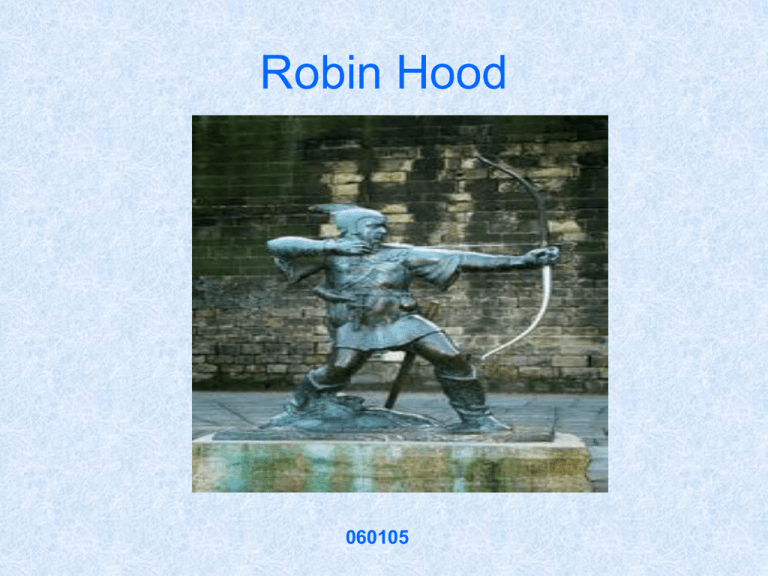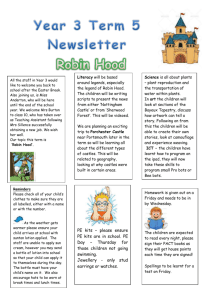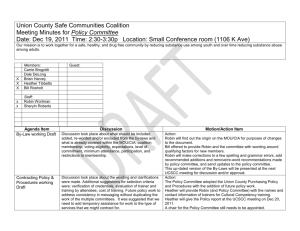Robin Hood's Birth, Breeding, Valor, and Marriage
advertisement

Robin Hood 060105 Robin Hood • Robin Hood is an archetypal figure in English folklore, whose story originates from medieval times but who remains significant in popular culture where he is painted as a man known for robbing the rich to give to the poor and fighting against injustice and tyranny. His band consists of a "seven score" group of fellow outlawed yeomen – called his "Merry Men".He has been the subject of numerous films, television series, books, comics, and plays. In the earliest sources Robin Hood is a commoner, but he would often later be portrayed as the dispossessed Earl of Huntingdon. There is no consensus as to whether or not Robin Hood is based on any historical figure and little reliable historical evidence exists to support either side of this debate. OVERVIEW • In popular culture Robin Hood and his band are usually seen as living in Sherwood Forest in Nottinghamshire. Much of the action of the early ballads does take place in Nottinghamshire, and the very earliest known ballad does show the outlaws operating in Sherwood Forest.So does the very first recorded Robin Hood rhyme, four lines from the beginning of the 15th century beginning "Robyn hode in scherewode stod" However, the overall picture from the surviving early ballads and other early references shows Robin Hood based in the Barnsdale area of what is now South Yorkshire (which borders Nottinghamshire), and other traditions also point to Yorkshire. A tradition dating back at least to the end of the 16th century gives his birthplace as Loxley in South Yorkshire, while the site of Robin Hood's Well in Yorkshire has been associated with Robin Hood at least since 1422. His grave has been claimed to be at Kirklees Priory in West Yorkshire, as implied by the 18th century version of Robin Hood's Death, and there is a headstone there of dubious authenticity FIGHTING • Within Robin Hood's band medieval forms of courtesy rather than modern ideals of equality are generally in evidence. In the early ballads Robin's men usually kneel before him in strict obedience: in A Gest of Robyn Hode the king even observes that "His men are more at his byddynge/Then my men be at myn". Their social status, as yeomen, is shown by their weapons; they use swords rather than quarterstaffs. The only character to use a quarterstaff in the early ballads is the potter, and Robin Hood does not take to a staff until the 18th century . • • It is from this association that Robin's romantic attachment to Maid Marian (or Marion) stems. The naming of Marian may have come from the French pastoral play of c. 1280, the Jeu de Robin et Marion, although this play is unrelated to the English legends. Both Robin and Marian were certainly associated with May Day festivities in England (as was Friar Tuck), but these were originally two distinct types of performance — Alexander Barclay, writing in c.1500, refers to "some merry fytte of Maid Marian or else of Robin Hood" — but the characters were brought together. Marian did not immediately gain the unquestioned role; in Robin Hood's Birth, Breeding, Valor, and Marriage, his sweetheart is 'Clorinda the Queen of the Shepherdesses'. Clorinda survives in some later stories as an alias of Marian. In the 16th century, Robin Hood is given a specific historical setting. Up until this point there was little interest in exactly when Robin's adventures took place. The original ballads refer at various points to 'King Edward', without stipulating whether this is Edward I, Edward II, or Edward III. Hood may thus have been active at any point between 1272 and 1377. However, during the 16th century the stories become fixed to the 1190s, the period in which King Richard was absent from his throne, fighting in the crusades. This date is first proposed by John Mair in his Historia Majoris Britanniæ (1521), and gains popular acceptance by the end of the century. The End





